剑桥少儿英语 fruit 公开课
新版剑桥少儿英语一至三级[全]大讲义
![新版剑桥少儿英语一至三级[全]大讲义](https://img.taocdn.com/s3/m/52d7495427d3240c8447efd1.png)
新版剑桥少儿英语一至三级[全]大讲义剑桥少儿英语剑桥少儿英语是资深的国际权威考核机构——英国剑桥大学考试委员会(University of Cambridge Local Examinations Syndicate,简称UCLES),为培养、提高英语为非母语国家少年儿童的英语能力而精心设计的,它为6—12岁少年儿童提供了一个全方位的教学评测方案,为他们走进英语世界迈出良好的第一步。
剑桥少儿英语分为:预备级(Pro-Starters)、一级(Starters)、二级(Movers)和三级(Flyers)。
预备级:适合5-6岁,经过大约80小时的英语学习,掌握约280个词汇的学生参加,预备级考试只设口试,无听力和读写内容;剑桥少儿英语考试一级(Starters):一级:适合6-8岁,经过大约100小时的英语学习,掌握约460个词汇的学生参加(07版剑桥考试大纲词汇量为459个,旧版剑桥考试大纲词汇量为439个);剑桥少儿英语考试二级(Movers):二级:适合8-11岁,经过大约100小时的英语学习,掌握约770个词汇的学生参加(07版剑桥考试大纲词汇量为772个,旧版剑桥考试大纲词汇量为674个);剑桥少儿英语考试三级(Flyers):三级:适合9-12岁,经过大约150小时的英语学习,掌握约430个词汇的学生参加(07版剑桥考试大纲词汇量为427个,旧版剑桥考试大纲词汇量为398个)。
考试大概内容:读写(Reading and Writing )这个部分是个笔试部分,时间为:20分钟(一级)到40分钟(三级)。
文字篇幅比较短小,由一些固定内容的单词和结构组成。
考生只需要进行简单的操作如选择和打勾,用单词和短语填空,回答灵活性的问题。
试卷被送往剑桥大学考试委员会打分。
听力(Listening)这个部分也是一个笔试部分。
时间为:20分钟(一级和三级),25分钟(二级)。
和读写部分一样,考试内容局限在考试指定的内容。
牛津小学英语1AUnit5Fruit教案

牛津小学英语1AUnit5Fruit教案课型新授课时2主备人汤雪莲教学日期教学要求1. using formulaic expressions to greet people.2. using simple present sense to indicate habitual actions.3. learn the song.教学重难点simple present tense. i take my bag and book to school.教具学具multimedia, cassette教学活动内容教学活动内容与主要问题的设置执教人修改内容师生活动要点pre-task preparation1.do the actions. stand up, please. sit down, please. open your book. close your book. clap your hands. stamp your feet. come here, please. go back to your seat.2.say a rhyme learned in last class.while-task procedure1.greeting each other. good morning, a. good morning b.2. teach word, teacher. (point myself) t: i’m a teacher. let ss repeat: teacher.3.say i take a pencil, and do the action.4.teach word school. show a picture of school. let ss say mysay a rhyme learned in last class. 教学活动内容教学活内容与主要问题的设置执教人修改内容师生活动要点5. (teacher act and say). t: i take my bag and book to school.6. i take my bag and book, my bag and book to school.7. listen to the tape.8.sing after the tape.post-task activity sing and act the song.homeworksing a song .sing a song。
少儿英语水果教学fruit课件

少儿英语水果教学fruit课件一、教学内容本节课我们将学习教材《少儿英语》第三单元“Fruits”的部分。
详细内容包括:1. 水果词汇的学习:apple,banana,orange,grape,strawberry,pineapple,watermelon,mango。
2. 搭配颜色词汇:red,yellow,orange,purple,green,pink。
3. 使用“I like”句型表达对水果的喜爱。
二、教学目标1. 学生能够正确认读并拼写水果单词。
2. 学生能够运用颜色词汇描述水果。
3. 学生能够使用“I like”句型表达自己的喜好。
三、教学难点与重点1. 教学难点:正确拼写水果单词,使用“I like”句型进行表达。
2. 教学重点:掌握水果词汇和颜色词汇,运用所学进行简单对话。
四、教具与学具准备1. 教具:PPT课件,水果卡片,颜色卡片,磁铁板。
2. 学具:学生用书,练习册,彩色笔。
五、教学过程1. 导入:通过展示水果实物和图片,引导学生说出水果的英文名称,复习颜色词汇。
2. 新课内容:学习水果词汇,进行单词卡片游戏,学生分组比赛,认读水果单词。
3. 句型学习:通过PPT课件,展示“I like”句型,并进行例句讲解。
4. 实践情景:设计水果店购物场景,学生分角色扮演,使用所学句型和词汇进行对话。
5. 例题讲解:讲解练习册中的例题,指导学生完成练习。
6. 随堂练习:学生在课堂上完成水果单词拼写和句型练习,教师实时反馈。
六、板书设计1. 水果词汇:apple,banana,orange,grape,strawberry,pineapple,watermelon,mango。
2. 颜色词汇:red,yellow,orange,purple,green,pink。
3. 句型:“I like”七、作业设计1. 作业题目:(1)抄写水果单词和颜色词汇。
(2)用“I like”句型,写出自己喜欢的水果。
剑桥少儿英语公开课ppt课件

Intonation imitation and application
01
Rising and falling tones
Master the rising and falling tones in English sentences,
expressing different emotions and tones.
03
Enhance students' cross-cultural awareness and international perspective
04
Cultivate students' self-learning ability and collaborative spirit
Textbook content and structure
Understand the phenomena of linking, weak reading, and omission in English, and improve the naturalness of spoken language.
Sound variation rules
Learn the sound variation rules in English, such as plosives, fricatives, etc., to make pronunciation more authentic.
Ask for information sentence structures such as "What's your name?" and "How old are you?" to cultivate students' ability to communicate proactively.
剑桥少儿英语教学计划
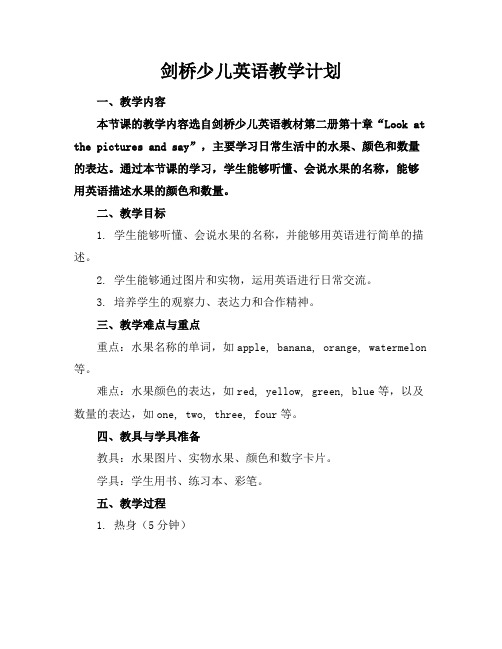
剑桥少儿英语教学计划一、教学内容本节课的教学内容选自剑桥少儿英语教材第二册第十章“Look at the pictures and say”,主要学习日常生活中的水果、颜色和数量的表达。
通过本节课的学习,学生能够听懂、会说水果的名称,能够用英语描述水果的颜色和数量。
二、教学目标1. 学生能够听懂、会说水果的名称,并能够用英语进行简单的描述。
2. 学生能够通过图片和实物,运用英语进行日常交流。
3. 培养学生的观察力、表达力和合作精神。
三、教学难点与重点重点:水果名称的单词,如apple, banana, orange, watermelon 等。
难点:水果颜色的表达,如red, yellow, green, blue等,以及数量的表达,如one, two, three, four等。
四、教具与学具准备教具:水果图片、实物水果、颜色和数字卡片。
学具:学生用书、练习本、彩笔。
五、教学过程1. 热身(5分钟)教师与学生用中文进行简单的问候,然后引入本节课的主题。
教师展示一些水果的实物或图片,让学生猜测水果的名称,并简单描述水果的颜色和数量。
2. 引入(10分钟)教师展示本节课的水果图片,引导学生用中文说出水果的名称,然后用英语重复。
教师引导学生观察水果的颜色和数量,并用中文进行描述。
3. 讲解(15分钟)教师讲解水果名称的英文表达,如apple, banana, orange, watermelon等,并教授水果颜色的表达,如red, yellow, green,blue等,以及数量的表达,如one, two, three, four等。
4. 练习(10分钟)教师给出一些水果的图片或实物,让学生用英语说出水果的名称,并描述水果的颜色和数量。
教师可以组织学生进行小组活动,互相练习。
六、板书设计教师在黑板上写出本节课的水果名称,如apple, banana, orange, watermelon等,并在旁边标注中文翻译。
剑桥少儿英语教案(全)
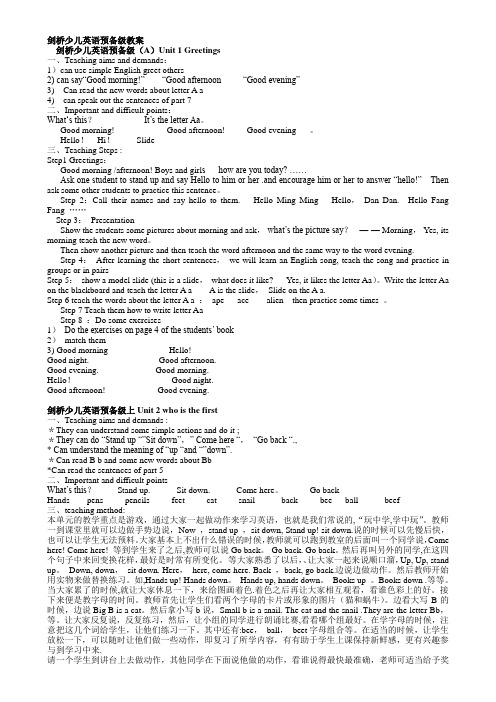
剑桥少儿英语预备级教案剑桥少儿英语预备级(A)Unit 1 Greetings一、Teaching aims and demands:1)can use simple English greet others2) can say“Good morning!” “Good afternoon “Good evening”3) Can read the new words about letter A a4) can speak out the sentences of part 7二、Important and difficult points:What‘s this?It’s the letter Aa。
Good morning! Good afternoon! Good evening 。
Hello!Hi!Slide三、Teaching Steps :Step1 Greetings:Good morning /afternoon! Boys and girl s how are you today? ……Ask one student to stand up and say Hello to him or her .and encourage him or her to answer “hello!” Then ask some other students to practice this sentence。
Step 2:Call their names and say hello to them. Hello Ming Ming Hello,Dan Dan. Hello Fang Fang ……Step 3:PresentationShow the students some pictures about morning and ask,what’s the picture say?-—-— Morning,Yes, its morning teach the new word。
一年级上册英语教案-Unit6《Fruit》(StoryTime)|人教(新起点)

一年级上册英语教案-Unit 6《Fruit》(Story Time)|人教(新起点)教学内容本单元《Fruit》以水果为主题,通过Story Time环节,学生将学习如何用英语描述和表达水果。
教学内容主要包括水果词汇的引入、句型的构造、以及围绕水果的简单对话。
教学目标1. 学生能够识别并正确发音本单元所学的英语水果词汇。
2. 学生能够使用简单的句型描述水果,如"What's this?" "It's an apple."。
3. 学生能够在小组活动中运用所学词汇和句型进行交流。
4. 学生能够理解并参与关于水果的英语小故事。
教学难点1. 水果词汇的正确发音,尤其是相似音素的区分。
2. 句型的正确构造和使用。
3. 在实际对话中的词汇和句型的应用。
教具学具准备1. 水果卡片或实物。
2. 教学挂图或PPT。
3. 录音设备。
4. 学生练习册。
教学过程第一阶段:引入通过展示水果卡片或实物,引导学生用中文识别并命名水果。
教师用英语介绍水果,让学生模仿并跟读。
第二阶段:学习教师通过教学挂图或PPT展示句型,并引导学生理解句意。
学生跟读并模仿句型。
进行小组活动,学生之间用句型进行对话练习。
第三阶段:应用学生分组,每组选择一种水果,用所学句型编写小对话。
各小组展示对话,教师给予反馈。
第四阶段:巩固教师讲述一个简单的英语小故事,内容围绕水果。
学生听故事并回答问题。
学生复述故事。
板书设计本单元的重点水果词汇。
句型构造示例。
小组活动的指导要求。
作业设计1. 学生完成练习册上的相关练习。
2. 学生用所学句型编写关于水果的简单对话。
3. 家长协助,让学生在家中用英语介绍不同的水果。
课后反思课后,教师应反思教学内容是否适当,学生是否能够达到教学目标,教学难点是否得到有效解决。
同时,教师应根据学生的反馈调整教学方法,以便更好地适应学生的学习需求。
本文档共计约600字,如需进一步细化或扩展,请根据实际教学情况进行调整。
《剑桥少儿英语》PPT课件

阅卷: 阅卷是由剑桥大学经过挑选的,受到剑桥大学考试委员会监督下的
旧版证书
旧版证书
2007年1月第三版《剑桥少儿英语》教材系列是由教育部考试中心中英教育测量交流中心组编、北京新知堂教育科 技开发有限公司制作、西安交通大学出版社出版发行,是"剑桥少儿英语"学习系统唯一指定的培训版教材,该教材 于2008年7月进行了第一次修定。
这套教材专为我国6~12岁的年龄段的少年儿童学习英语而设计。本教材不仅完全符合剑桥少儿英语大纲的教学 要求,而且参照了《英语教学大纲》(教育部制定的九年义务教育全日制初级中学教学大纲,人民教育出版社出版) 及国内外比较有代表性的儿童英语教学标准,在内容和形式上反映了少儿的认知能力和心理特征,突出了"活泼、 有趣、轻松、连续"的特色。
作大部分在剑桥来完成,口语考试部分是面对面的,考生的表现是由经过培训的合格的考官来评估,他 们也要接受标准的管理和监督。在给出盾牌时,剑桥大学考试委员会将参考当地考试机构上报的考试情 况汇报,以保证考试的公平性。
成绩单: 原始成绩单是通过各地的考点将成绩在发放证书前进行发布的。成绩单只包含个人的卷面分数。 在成绩证书发放之前剑桥大学考试委员可能修改原始成绩。原始成绩的修改可能(很少)是因为考 生的成绩查询产生的成绩更正,或者(更少)是因为由剑桥大学考试委员会对成绩进行的例行复查发现 的成绩更正。 因为安全原因,剑桥大学考试委员不直接向单个考生发布成绩。如果你对成绩有疑问,请和参加考 试的考点联系。
小班英语《Fruit》教学课件.
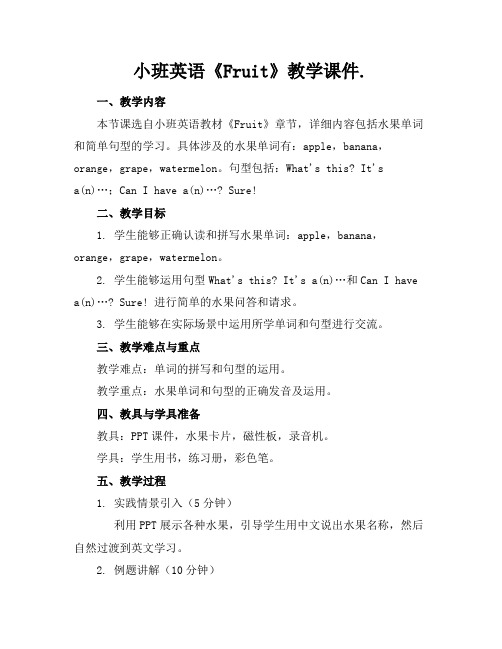
小班英语《Fruit》教学课件.一、教学内容本节课选自小班英语教材《Fruit》章节,详细内容包括水果单词和简单句型的学习。
具体涉及的水果单词有:apple,banana,orange,grape,watermelon。
句型包括:What's this? It'sa(n)…;Can I have a(n)…? Sure!二、教学目标1. 学生能够正确认读和拼写水果单词:apple,banana,orange,grape,watermelon。
2. 学生能够运用句型What's this? It's a(n)…和Can I have a(n)…? Sure! 进行简单的水果问答和请求。
3. 学生能够在实际场景中运用所学单词和句型进行交流。
三、教学难点与重点教学难点:单词的拼写和句型的运用。
教学重点:水果单词和句型的正确发音及运用。
四、教具与学具准备教具:PPT课件,水果卡片,磁性板,录音机。
学具:学生用书,练习册,彩色笔。
五、教学过程1. 实践情景引入(5分钟)利用PPT展示各种水果,引导学生用中文说出水果名称,然后自然过渡到英文学习。
2. 例题讲解(10分钟)讲解单词:apple,banana,orange,grape,watermelon,配合水果卡片进行认读。
讲解句型:What's this? It's a(n)…;Can I have a(n)…? Sure!3. 随堂练习(10分钟)学生两人一组,利用水果卡片进行单词和句型的练习,教师巡回指导。
4. 小组活动(10分钟)学生分为若干小组,每组选择一种水果进行角色扮演,运用所学句型进行交流。
6. 游戏环节(10分钟)利用磁性板进行水果单词接龙游戏,提高学生的反应能力和单词记忆。
六、板书设计板书分为两部分:水果单词和句型。
1. 水果单词:用大号字体书写apple,banana,orange,grape,watermelon,每个单词下方附上相应的图片。
剑桥少儿英语教案(全)
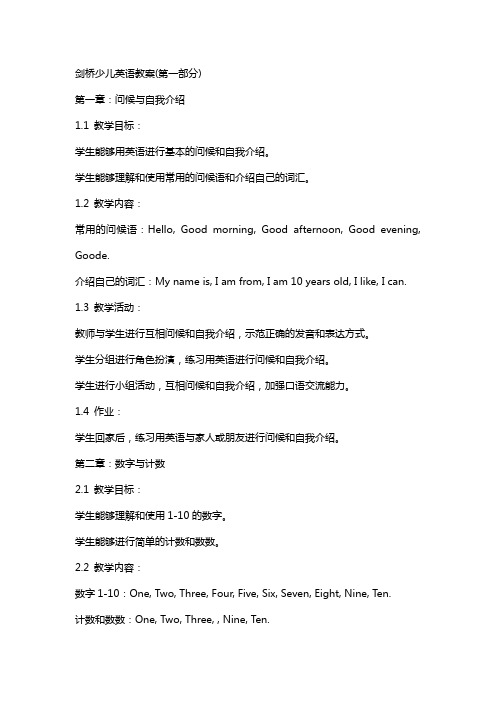
剑桥少儿英语教案(第一部分)第一章:问候与自我介绍1.1 教学目标:学生能够用英语进行基本的问候和自我介绍。
学生能够理解和使用常用的问候语和介绍自己的词汇。
1.2 教学内容:常用的问候语:Hello, Good morning, Good afternoon, Good evening, Goode.介绍自己的词汇:My name is, I am from, I am 10 years old, I like, I can. 1.3 教学活动:教师与学生进行互相问候和自我介绍,示范正确的发音和表达方式。
学生分组进行角色扮演,练习用英语进行问候和自我介绍。
学生进行小组活动,互相问候和自我介绍,加强口语交流能力。
1.4 作业:学生回家后,练习用英语与家人或朋友进行问候和自我介绍。
第二章:数字与计数2.1 教学目标:学生能够理解和使用1-10的数字。
学生能够进行简单的计数和数数。
2.2 教学内容:数字1-10:One, Two, Three, Four, Five, Six, Seven, Eight, Nine, T en.计数和数数:One, Two, Three, , Nine, Ten.2.3 教学活动:教师出示数字卡片,学生能够正确说出数字。
学生进行数数游戏,练习计数和数数。
学生分组进行数字接龙游戏,加强数字的认识和记忆。
2.4 作业:学生回家后,练习写数字1-10,并尝试进行简单的计数和数数。
第三章:颜色3.1 教学目标:学生能够理解和使用常用的颜色词汇。
学生能够描述物体的颜色。
3.2 教学内容:常用的颜色词汇:Red, Yellow, Blue, Green, White, Black, Brown, Pink, Purple, Orange.3.3 教学活动:教师出示不同颜色的物体,学生能够正确说出颜色。
学生进行颜色匹配游戏,练习识别和描述颜色。
学生分组进行颜色接力游戏,加强颜色词汇的记忆和运用。
幼儿园英语《fruits》教案
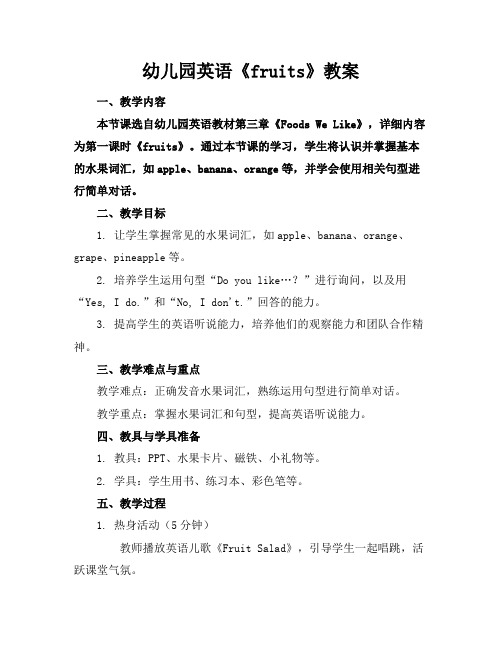
幼儿园英语《fruits》教案一、教学内容本节课选自幼儿园英语教材第三章《Foods We Like》,详细内容为第一课时《fruits》。
通过本节课的学习,学生将认识并掌握基本的水果词汇,如apple、banana、orange等,并学会使用相关句型进行简单对话。
二、教学目标1. 让学生掌握常见的水果词汇,如apple、banana、orange、grape、pineapple等。
2. 培养学生运用句型“Do you like…?”进行询问,以及用“Yes, I do.”和“No, I don't.”回答的能力。
3. 提高学生的英语听说能力,培养他们的观察能力和团队合作精神。
三、教学难点与重点教学难点:正确发音水果词汇,熟练运用句型进行简单对话。
教学重点:掌握水果词汇和句型,提高英语听说能力。
四、教具与学具准备1. 教具:PPT、水果卡片、磁铁、小礼物等。
2. 学具:学生用书、练习本、彩色笔等。
五、教学过程1. 热身活动(5分钟)教师播放英语儿歌《Fruit Salad》,引导学生一起唱跳,活跃课堂气氛。
学生跟随歌曲节奏,模仿水果动作。
2. 引入新课(10分钟)教师展示水果卡片,引导学生说出水果的名称,并教授新词汇。
学生跟读水果词汇,注意模仿教师的发音。
3. 句型学习(10分钟)教师用句型“Do you like…?”询问学生喜欢的水果,引导学生用“Yes, I do.”和“No, I don't.”回答。
学生进行角色扮演,进行句型练习。
4. 小组活动(15分钟)学生分成小组,用水果卡片进行“找朋友”游戏,练习句型和词汇。
教师巡回指导,纠正发音和语法错误。
5. 随堂练习(10分钟)教师出示PPT,展示水果图片,学生用英语描述水果特征。
学生完成练习册上的相关练习。
教师邀请学生上台展示所学内容,给予表扬和鼓励。
六、板书设计1. Fruits2. 内容:水果词汇:apple、banana、orange、grape、pineapple等。
2024剑桥国际少儿英语全套教学课件

剑桥国际少儿英语全套教学课件目录•Introduction to Cambridge International Children's English •Training of Listening and Speaking Skills•Improving reading and writing skills •Consolidating vocabulary and grammar knowledge•Cultural background and cultivationof cross cultural communicationskills•Establishment of course evaluation 目录and feedback mechanism01 Introduction to Cambridge International Children's EnglishTeaching philosophy and objectives010405060302Textbook System and CharacteristicsApplicable objects and advantages02 Training of Listening and Speaking SkillsListening training strategiesPredictive listening01Selective listening02Intensive listening03Oral expression skillsVocabulary developmentSentence structureFluent deliveryScenario dialogue exampleRole playsInformation gap activitiesConversational exchanges03Improving reading and writing skillsEnhance students to predict what they will read about based on the title, headings, and any accompanying imagesPredicting contentTeach students how to quickly read through a text to get the gift of the information (skimming) and how to search forspecific details (scanning)Skimming and scanningHelp students build their vocabulary by teaching them strategies to see the meaning of unknown words from context clubsUnderstandin g vocabularyGuide students to read between the lines and make references based on what they have readInferring informationReading comprehension methodsWriting Skills GuideRecommendation and comments on model essays04 Consolidating vocabulary and grammar knowledge输入标题02010403Vocabulary memory methods0102TensesNounsAdjectives …PositionsSentence structure030405Summary of grammar pointsPractice question bank and answers Multiple choice questions Gap fill exercisesTranslation exercises Writing prompts05Cultural background and cultivation of cross cultural communication skillsIntroduction to English speaking Counties and CulturesOverview of major English speaking countriesCustoms and conditionsValues and ways of thinkingCross border communication etiquette guidanceBasic communication etiquetteand farewellsDining etiquetteand wine cultureBusiness etiquetteRole playing activities Cultural exchangeactivitiesPracticalapplication tasksDesign and organization of practical activities06 Establishment of course evaluation and feedback mechanismStudent self-assessment report templateDesign of self-assessment questionsincluding speaking, listening, reading, writing, and other aspects tocomprehensively evaluate students' English proficiencyRegular submission of self-assessment reportsrequesting students to submit self-assessment reports on a regular basis tohelp teachers understand students' learning progress and differencesGuidance and feedback on self-assessmentteachers provide guidance and feedback on students' self-assessment reportsto help students improve their learning methods and strategiesConstruction of Teacher Evaluation Index System Establishment of evaluation criteriaCollection and analysis of evaluation dataFeedback and improvement measuresParental feedback channel settingsEstablishment of parent feedback channelsCollection and handling of parental feedbackFeedback and communication with parentsTHANKS 感谢观看。
2024年小班英语《Fruit》教学课件.
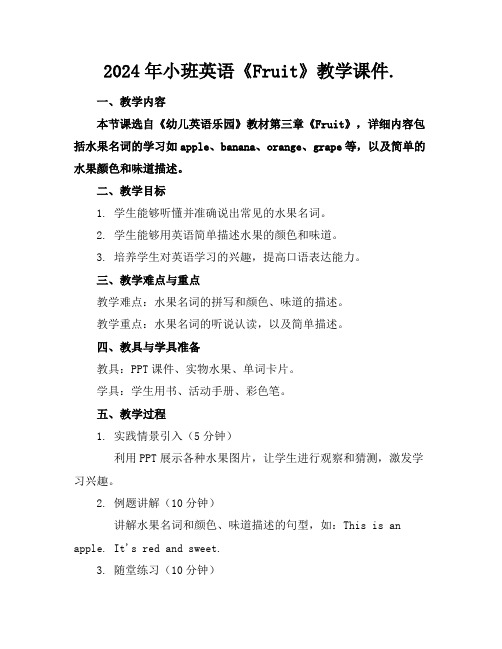
2024年小班英语《Fruit》教学课件.一、教学内容本节课选自《幼儿英语乐园》教材第三章《Fruit》,详细内容包括水果名词的学习如apple、banana、orange、grape等,以及简单的水果颜色和味道描述。
二、教学目标1. 学生能够听懂并准确说出常见的水果名词。
2. 学生能够用英语简单描述水果的颜色和味道。
3. 培养学生对英语学习的兴趣,提高口语表达能力。
三、教学难点与重点教学难点:水果名词的拼写和颜色、味道的描述。
教学重点:水果名词的听说认读,以及简单描述。
四、教具与学具准备教具:PPT课件、实物水果、单词卡片。
学具:学生用书、活动手册、彩色笔。
五、教学过程1. 实践情景引入(5分钟)利用PPT展示各种水果图片,让学生进行观察和猜测,激发学习兴趣。
2. 例题讲解(10分钟)讲解水果名词和颜色、味道描述的句型,如:This is an apple. It's red and sweet.3. 随堂练习(10分钟)1)教师展示水果,学生抢答说出水果名词。
2)教师说出水果名词,学生抢答描述水果颜色和味道。
4. 小组活动(10分钟)学生分组,每组选择一种水果进行角色扮演,用英语介绍水果的颜色和味道。
教师邀请学生分享所学内容,对学生的表现给予鼓励和表扬。
六、板书设计1. 水果名词:apple、banana、orange、grape等。
2. 颜色和味道描述:red、yellow、orange、sweet、sour等。
3. 句型:This is a(n) It's and七、作业设计1. 作业题目:1)根据所给图片,写出相应的水果名词。
2)用英语描述你所喜欢的水果的颜色和味道。
2. 答案:1)apple、banana、orange、grape2)例:I like grapes. They are purple and sweet.八、课后反思及拓展延伸1. 课后反思:观察学生在课堂上的表现,了解他们对水果名词和描述的学习情况,针对问题进行个别辅导。
剑桥少儿英语预备级公开课课件
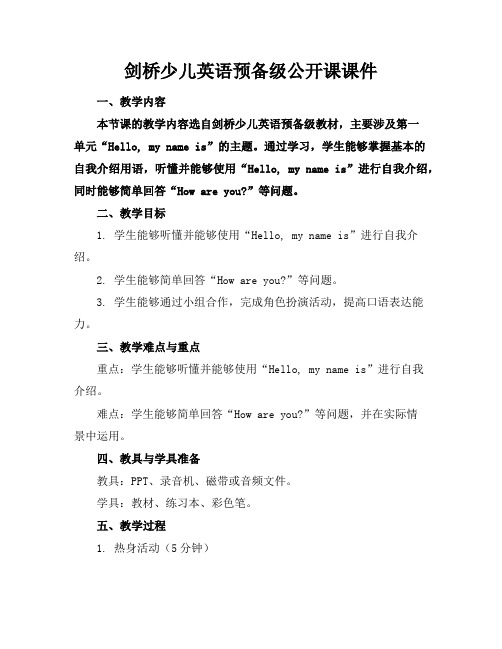
剑桥少儿英语预备级公开课课件一、教学内容本节课的教学内容选自剑桥少儿英语预备级教材,主要涉及第一单元“Hello, my name is”的主题。
通过学习,学生能够掌握基本的自我介绍用语,听懂并能够使用“Hello, my name is”进行自我介绍,同时能够简单回答“How are you?”等问题。
二、教学目标1. 学生能够听懂并能够使用“Hello, my name is”进行自我介绍。
2. 学生能够简单回答“How are you?”等问题。
3. 学生能够通过小组合作,完成角色扮演活动,提高口语表达能力。
三、教学难点与重点重点:学生能够听懂并能够使用“Hello, my name is”进行自我介绍。
难点:学生能够简单回答“How are you?”等问题,并在实际情景中运用。
四、教具与学具准备教具:PPT、录音机、磁带或音频文件。
学具:教材、练习本、彩色笔。
五、教学过程1. 热身活动(5分钟)教师播放英语歌曲,引导学生跟唱,活跃课堂气氛。
然后,教师邀请几名学生进行自我介绍,引入本节课的主题。
2. 新课导入(10分钟)教师通过PPT展示本节课的主要内容,讲解“Hello, my name is”的用法,并让学生跟读。
同时,教师通过例句展示如何回答“How are you?”,让学生进行听力练习。
3. 课堂练习(10分钟)学生分组进行角色扮演,模拟情景,练习自我介绍和回答“Howare you?”。
教师巡回指导,纠正发音,并给予鼓励。
4. 巩固练习(5分钟)教师给出一些简单的听力题目,让学生听录音并回答问题。
例如:“Hello, my name is How are you?”的录音,学生需要根据听力内容,填写空缺的部分。
5. 课堂小结(5分钟)六、板书设计板书内容主要包括本节课的主题“Hello, my name is”和“How are you?”的回答。
教师可以用简洁的词语和图示,帮助学生理解和记忆。
2024剑桥少儿英语预备级公开课

剑桥少儿英语预备级公开课•Course Introduction and Background•Teaching content and methods •Classroom activities and interactive strategies•Homework and tutoring advice •Course evaluation and feedback •Summary and Outlook目录01Course IntroductionandBackgroundIntroduction to Cambridge Children's English SystemThe Cambridge Children's English System is a comprehensive Englishlanguage learning program specifically designed for young learners It aims to develop children's English language skills, including listening,speaking, reading, and writing, through fun and engaging activitiesThe system focuses on practical communication skills and resources childrento use English in real life situationsPositioning and Objectives of Preparatory Courses The preparatory courses are designed to prepare children for theCambridge Children's English System and other English languageprogramsThey focus on building a solid foundation in basic Englishlanguage skills, such as vocabulary, grammar, and promotionThe objectives of the preparatory courses are to help childrendevelop confidence in using English, improve their learningabilities, and enhance their motivation to learnNeeds analysis is conducted to identify each child's level of English proficiency and learning style, allowing for personalized instruction and targeted practiceThe preparatory courses are suitable for children aged 5 to 12 years old who have little or no prior knowledge of English Children in this age group typically have short attention spans and learn best through interactive andplayful activitiesStudent group and needs analysisThe preparatory courses use a variety of textbooks and teaching resources that are specifically designed for young learnersTeachers also have access to a range of supportmaterials, including less plans, activity ideas,and assessment tools to ensure effective andeffective delivery of the course contentThese resources include colorful illustrations,engaging stories, and interactive exercises thatmake learning fun and accessibleOverview of Textbooks and Teaching Resources02Teachingcontent andmethodsKey points of teaching phonetics, vocabulary, and grammarPhoneticsEmphasis on the promotion and introduction ofEnglish sounds, and help students master the basicphone knowledge and skillsVocabularyTeach students high frequency words and phrasesin English, and guide them to learn vocabularythrough context and associationGrammarIntroduce basic English grammar rules andstructures, and help students understand and applythem in practical language useListeningDevelop students' ability to understand spoon English through listening activities such as listening to stories, songs, and dialogues SpeakingEncourage students toexpress themselves inEnglish and improve theiroral communication skillsthrough role plays,discussions, andpresentationsReadingGuide students to readEnglish texts, understand themain ideas, and extract keyinformation through readingcomprehension exercisesWritingHelp students write simpleEnglish texts such as letters,stories, and essays, andimprove their writing skillsthrough writing practice andfeedback01020304Training of listening, speaking, reading, and writing skillsMultimedia teaching and interactive designMultimedia resourcesUtilize multimedia resources such as videos, audiorecordings, and interactive software to enhancestudents' learning experienceInteractive designDesign interactive activities and games that engagestudents in the learning process and make learningmore fun and effectiveThe application of gamified teaching method in preparation levelGamification elementsIncorporate gaming elements such as points, bags, and leaderboardsto motivate students and enhance their learning experiencePreparation level adaptationAdapt the gamified teaching method to the preparation level bydesigning appropriate games and activities that are suitable for younglearners and help them achieve their learning goals03Classroomactivities andinteractivestrategiesDesign and practice of role playing gamesRole allocation and scenario settingAssign roles to students based on their interests and English proficiency, anddesign authentic scenarios to enhance their language integrationLanguage functions and communication skillsFocus on the language functions and communication skills needed for each role,and provide opportunities for students to practice and improve their languageuseTeacher guidance and feedbackProvide guidance and feedback to students during the role playing process,helping them to better understand and master the target languageThe Application of Songs and Children's Rhymes in English TeachingSelection of appropriate songs and rhymesChoose songs and rhymes that are appropriate for the target age group and language level, andensure they are engaging and educationalIntegration into classroom activitiesIntegrate songs and rhymes into various classroom activities, such as warm ups, transitions, andreviews, to enhance students' learning experienceEncouraging student participationEncourage students to actively participate in singing and rhyming activities, and provideopportunities for them to perform in front of the classEstablishment of group cooperation and competition mechanismGroup formation and task allocationForm groups of students based on their abilities and interests, and assigntasks that require cooperation and teamworkCollaborative learning activitiesDesign collaborative learning activities that resource students to worktogether to achieve a common goalCompetition and rewardsIntroduce competition among groups and provide rewards for outstandingperformance to motivate students and enhance their sense of acceptanceEncoding evaluation strategies and implementation effects•Student self-evaluation: Enhance students to reflect on their own performance and identify areas for improvement•Peer evaluation: Provide opportunities for peers to evaluate each other's performance, promoting a sense of community and multiple support•Teacher evaluation and feedback: Regularly evaluate students' progress and provide constructive feedback to help them improve their language skills and learning strategies•Implementation effects: Monitor the implementation effects of the evaluation strategies and adjust as necessary to ensure they are effective in motivating students and improving their language proficiency04Homeworkand tutoringadviceHomework types and diversity settingsDiverse home typesInclude reading comprehension, vocabulary exercises, grammar practice,writing tasks, and oral practice to comprehensively improve children'sEnglish skillsAppropriate diversity levelsSet home diversity levels based on children's English proficiency andlearning objectives, ensuring that they are challenging but achievableEncourage active participation01Encourage children to actively participate in English learningactivities, such as role playing, singing English songs, andwatching English movies Foster autonomous learning02Guide children to develop autonomous learning habits, such assetting learning goals, planning learning time, and self-evaluation progress Provide emotional support03Offer endowment and support to children during the learningprocess, helping them overcome difficulties and build confidence Parental guidance on children's English learning methods01 02 03Quality online resourcesRecommend reproducible online English learning platforms and resources, such as online courses, learning apps, and interactive games, to enhance children's learning experienceOffline learning materialsIntroduce suitable offline learning materials, such as textbooks, workbooks, and reading materials, to complete online learning and provide additional practice opportunitiesBalanced utilizationGuide children to utilize both online and offline resources in a balanced way, taking advantage of the strengths of each to achieve optimal learning outcomesRecommendation and utilization of online and offline resourcesRegular progresstrackingEstablish a regular progress tracking system to monitor children's English learning progress and identify areas needing improvementTimely feedbackProvide timely feedback tochildren on their home andlearning performance, offeringconstructive suggestions andfundingCollaborativecommunicationEncourage opencommunication betweenparents, teachers, and childrento join address learningchallenges and cellularachievementsEstablishing a tracking and feedback mechanism05Course evaluation andfeedbackOral fluency, vocabulary, grammar accuracy, promotion,and ability to understand and respond to questionsOngoing assessments through class participation, home work, quizzes, and tests Regular progress reports provided to parentsAssessment criteria and methods for studentprogressMethodsCriteriaReflecting on teaching methods, classroom management, and student engagement Identifying strengths,weaknesses, and areas forimprovementSetting goals for personaland professionaldevelopmentWriting a self-evaluation report for teachersOpen ended questions allowing parents to providedetailed feedback Analysis of survey results to identify areas needingimprovementQuestions covering current, teaching quality, facilities, and overall satisfaction Design of a Parent Satisfaction Survey Questions naireContinuous improvement direction and measures Regular review of course materials and teaching methods to ensure they are up todate and effectiveOn going teacher training and development to enhance teaching skills andknowledgeCollecting and analyzing feedback from students, parents, and teachers to identifyareas for improvement and implementation changes as needed06Summary andOutlookSuccessful introduction to basic English vocabulary and grammarThrough interactive games and activities, students have acquired a solid foundation in English language fundamentalsEnhanced speaking and listening skillsRegular practice in speaking and listening activities hashelped students develop their communication skillsTHANKS感谢观看。
关于幼儿园小班英语教案《Fruit》含反思

关于幼儿园小班英语教案《Fruit》含反思一、教学内容本节课选自幼儿园小班英语教材《Fruit》章节,详细内容包括水果名词如apple、banana、orange、grape的学习,以及简单句型如“I like …”的运用。
二、教学目标1. 让幼儿能够听懂并准确说出四种水果的英文名称。
3. 通过学习水果,培养幼儿对英语学习的兴趣。
三、教学难点与重点教学难点:水果名词的发音及简单句型的运用。
教学重点:掌握四种水果的英文名称,并能用“I like …”表达自己的喜好。
四、教具与学具准备教具:水果卡片、挂图、磁性板、录音机、磁带。
学具:幼儿用书、彩色笔。
五、教学过程1. 实践情景引入(5分钟)教师展示各种水果实物,让幼儿用中文说出水果名称,然后引导幼儿用英语说出水果名称。
2. 例题讲解(10分钟)教师分别展示apple、banana、orange、grape的卡片,教读单词,并让幼儿跟读。
然后,教师用“I like …”句型表达自己喜欢的水果,引导幼儿模仿。
3. 随堂练习(10分钟)教师分发水果卡片,让幼儿两人一组,用“I like …”句型进行对话练习。
4. 小游戏(10分钟)教师将水果卡片放在磁性板上,让幼儿抢答,用英语说出水果名称。
六、板书设计板书分为两部分:左边展示四种水果的英文名称,右边展示“I like …”句型。
七、作业设计1. 作业题目:用英语画出自己喜欢的水果,并写上“Ilike …”。
2. 答案示例:画一个苹果,旁边写上“I like apple”。
八、课后反思及拓展延伸1. 反思:本节课通过实物展示、游戏互动等形式,让幼儿在轻松愉快的氛围中学习英语。
但在教学过程中,要注意关注每个幼儿的学习情况,确保他们都能掌握所学内容。
2. 拓展延伸:课后,教师可鼓励家长与幼儿一起进行水果主题的英语互动,如去超市购买水果时,用英语说出水果名称,巩固所学知识。
还可开展英语角活动,让幼儿在日常生活中更好地运用英语。
小班英语fruit教案与反思师徒结对
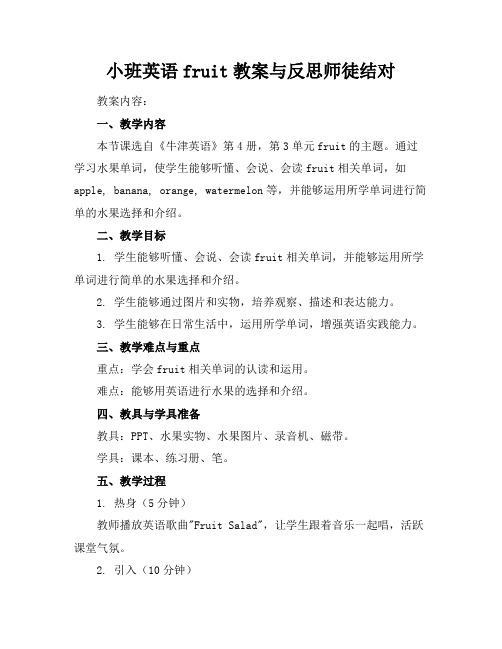
小班英语fruit教案与反思师徒结对教案内容:一、教学内容本节课选自《牛津英语》第4册,第3单元fruit的主题。
通过学习水果单词,使学生能够听懂、会说、会读fruit相关单词,如apple, banana, orange, watermelon等,并能够运用所学单词进行简单的水果选择和介绍。
二、教学目标1. 学生能够听懂、会说、会读fruit相关单词,并能够运用所学单词进行简单的水果选择和介绍。
2. 学生能够通过图片和实物,培养观察、描述和表达能力。
3. 学生能够在日常生活中,运用所学单词,增强英语实践能力。
三、教学难点与重点重点:学会fruit相关单词的认读和运用。
难点:能够用英语进行水果的选择和介绍。
四、教具与学具准备教具:PPT、水果实物、水果图片、录音机、磁带。
学具:课本、练习册、笔。
五、教学过程1. 热身(5分钟)教师播放英语歌曲"Fruit Salad",让学生跟着音乐一起唱,活跃课堂气氛。
2. 引入(10分钟)教师出示各种水果实物,引导学生用中文说出水果名称,然后提问:"Do you like fruit?", 引导学生用中文回答。
3. 呈现(10分钟)教师播放PPT,展示fruit相关单词的图片和单词,引导学生跟读。
教师分别出示apple, banana, orange, watermelon等单词,让学生模仿发音。
4. 实践(10分钟)教师将学生分成小组,每组发放一些水果和水果图片,让学生用英语进行水果选择和介绍。
教师巡回指导,纠正发音并给予鼓励。
5. 巩固(10分钟)教师出示一些水果图片,让学生用英语说出水果名称,并简单描述水果的特点。
教师也可以用英语提问,引导学生用英语回答。
六、板书设计板书水果单词,如apple, banana, orange, watermelon等,旁边加上中文翻译,方便学生学习和复习。
七、作业设计1. 抄写水果单词,每个单词写5遍。
- 1、下载文档前请自行甄别文档内容的完整性,平台不提供额外的编辑、内容补充、找答案等附加服务。
- 2、"仅部分预览"的文档,不可在线预览部分如存在完整性等问题,可反馈申请退款(可完整预览的文档不适用该条件!)。
- 3、如文档侵犯您的权益,请联系客服反馈,我们会尽快为您处理(人工客服工作时间:9:00-18:30)。
水果
by Cici
猜一猜
红红脸, 圆又圆, 亲一口,脆又甜。
(猜一水果 )
apple
身穿黄衣裳, 弯弯像月亮。 兄弟排一起, 个个甜蜜蜜。
猜一猜
(猜一水果 )
banana
猜一猜
紫红色的乒乓球, 吃到嘴里酸又甜。
(猜一水果 )
grape
头小肚子大, 身穿黄青褂。 样子像灯泡, 能吃不能照。
猜一猜
(猜一水果 )
pear
天下有一桃, 身上毛绒绒。 绿肉黑芝麻, 味道酸酸甜。。
猜一猜
(猜一水果 )
kiwi
plum
peach
apple
kiwi pear peach plum banana grape
考考你
pear
连一连
banana
apple peach
plum kiwi grape
Do you like apples?
你喜欢吃苹果吗?
Yes, I like apples. No, I don’t like apples.
Do you like bananas?
Yes, I like bananas.
No, I don’t like bananas.
Do you like plums?
Yes, I like plums.
No, I don’t like plums.
Do you like pears? Yes, I like pears. No, I don’t like pears.
apples
pears
plums
bananas
grapes
peaches kiwis
作业 1.问一问父母 Do you like apples? 2.画出你和爸爸妈妈喜欢 的水果
apple
kiwi pear peach plum banana grape
plums I like _________
apples I like _________ bananas I like _________
I like peaches.
pears I like ________.
I like kiwis.
banana
banana banena benana
apple
apple apble epple
pear
peer pear pera
plum
plum plam plunn
kiwi
kiwa kiwi kawi
grape
grabe grape graba
